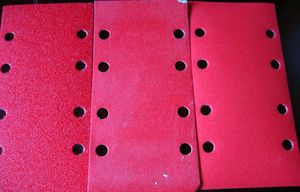After a Saturday afternoon Woodsmith Shop marathon, my nephew and my brother decided they were master wood workers. My brother’s garage is littered with big and small projects of varying degrees of completion and I got a lovingly-made jewelry box for my birthday. It’s splintery and uneven, but it does have a beautiful finish. They use linseed oil to finish all their pieces. It protects the wood and brings out its shine without a glossy, plastic-like finish. You can still feel the grain of the wood when you run your hand over the finished piece. I’ve now refinished all of the wood furniture in the house with it.
The Right Kind of Linseed Oil
I always thought linseed oil was linseed oil, but the hardware store’s shelf was packed full with different brands. I asked a surprisingly helpful teenage clerk and he said that the brand doesn’t matter. You’re looking for boiled linseed oil (sometimes called Danish linseed oil) is the best for home projects because it dries quickly. Turns out that “quickly” is relative. Boiled linseed oil takes around 24 hours to dry. Regular linseed oil can take three days or longer to dry.
Strip the Furniture Piece
Linseed oil can only protect unfinished wood. If your piece has any paint on its surface, strip it with a chemical paint stripper or sand it off. Lacquer thinner and mineral spirits remove a wide variety of wood finishes. If those don’t remove the finish, use the paint stripper or sand the finish off. Always sand in the direction of the grain of the wood. Sand just enough to remove the paint or finish and reveal dull wood. Wipe off any sanding dust with a tack cloth.
Clean the Wood
Put on rubber gloves to protect the furniture piece from your hands. Wet a chamois with soapy water and wring it out. You want to get it pretty dry. The first time I did this project I had to wait 24 hours for the wood to get dry enough to take linseed oil. You want it to be pretty dry. Wipe the furniture piece down. Check the rag a lot. If you notice dirt on the surface, wet and wring the rag again. Once the furniture is clean, follow with a clean water wipe to remove any soap residue. Leave the chair to dry for three to four hours.
Work Space
Work outside if at all possible. Linseed oil smells stronger than you think and it will take days to get the smell out of your house. The dog won’t stop sniffing around the area and it will drive you crazy. If you can’t work outside or in the garage, crack all the windows and get a fan going. Lay out a tarp or a few layers of unfolded newspaper sheets underneath the furniture sheet.
Linseed Oil
Pour a little linseed oil into a separate container. Dip a clean, dry chamois into the linseed oil. You want to moisten the rag but don’t soak it. The little drips get everywhere. Now wipe down the wood. Work in the direction of the grain. Use smooth, even strokes. Once the piece is coated, wipe off the excess with a dry, clean chamois. Let the surface dry for 24 hours then add another coat. The more coats you add, the more the grain of the wood will pop.
Clean Up
Don’t just ball the chamois up and forget about them. As linseed oil dries, it releases a gas that is super flammable and self-heating. When trapped in a crumpled towel the gas can heat up, ignite and set the rag on fire. Seriously. They will spontaneously combust and burn stuff up. Spread the chamois out flat and lay them outside until they dry. Then you can wash them.


